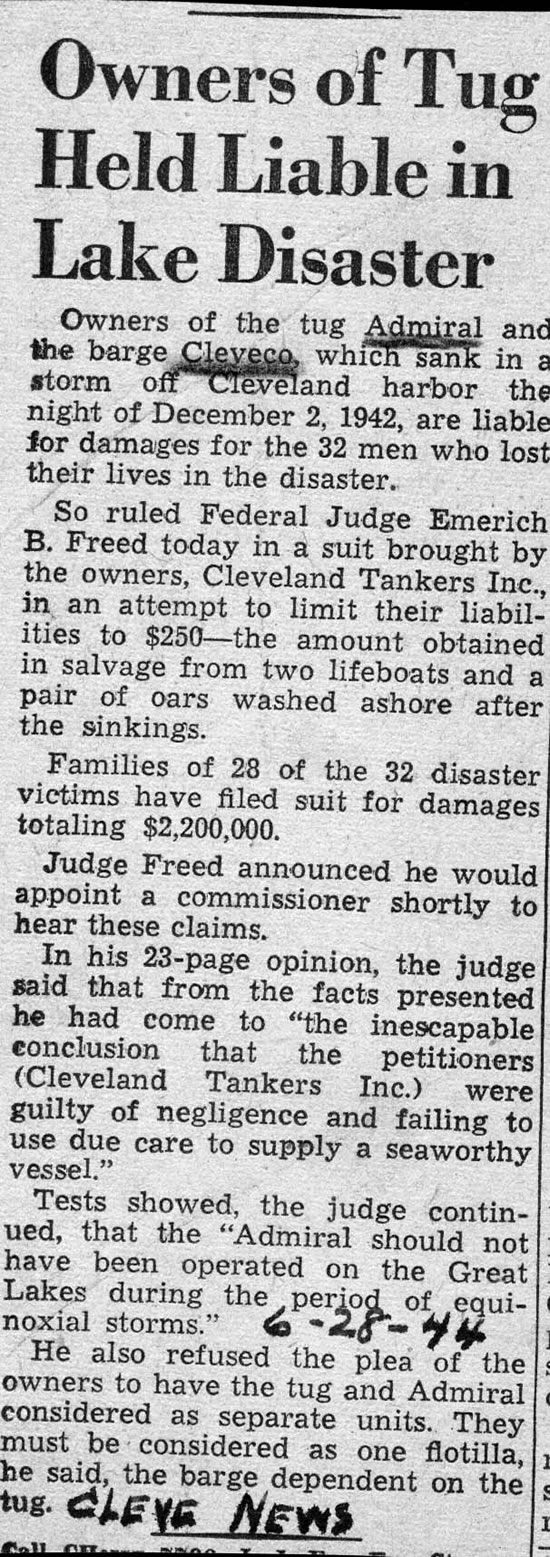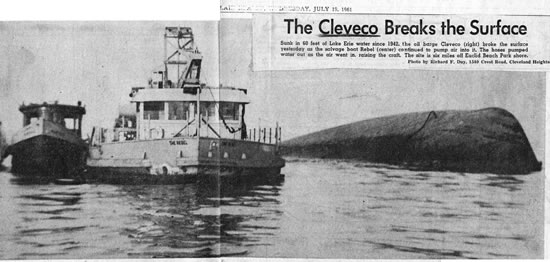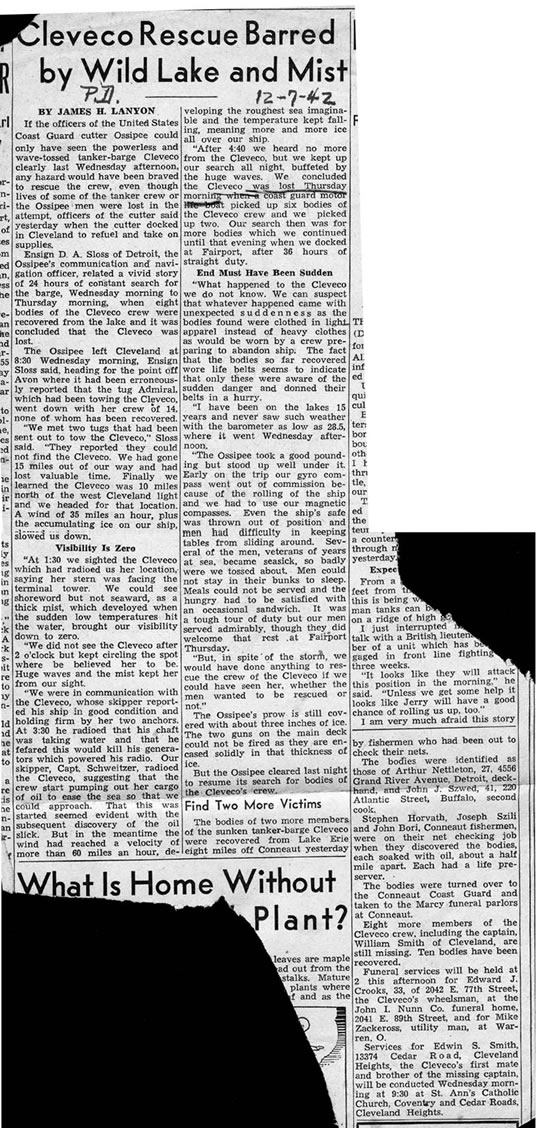Cleveco
| Ship Name: | Cleveco |
|---|---|
| Also Known As: | The CLEVECO had numerous other names. Under the original owner, Standard Oil, she was first named the S.O. & Co. #85, then renamed S.T. & Co. in 1916, followed by Scocony 85 in 1918, then the Gotham 85 in 1930, and finally the Cleveco in 1940. |
| Type of Ship: | Originally built as a sail barge. Was eventually operated as a steel tanker barge, with no means of motivation, meant to be towed by a tugboat. |
| Ship Size: | 260' x 43' x 25' |
| Ship Owner: | Cleveland Tankers, Inc. |
| Gross Tonnage: | 2441 |
| Net Tonnage: | NA |
| Typical Cargo: | Fuel oil, crude oil |
| Year Built: | 1913 - American Shipbuilding Company, Lorain, Ohio; originally for Standard Oil Co., originally as a sailing barge |
| Official Wreck Number: | 211035 |
|---|---|
| Wreck Location: | 41 47.468 N 81 36.006 W (Kohl) |
| Type of Ship at Loss: | Same |
| Cargo on Ship at Loss: | One million gallons of fuel oil |
| Captain of Ship at Loss: | Captain William H. Smith |
The Cleveco lies upside down in Lake Erie's mud and silt bottom, in 78 feet of water, approximately 14 miles north of Euclid, Ohio. The Cleveco's hull rises up and out of the bottom to a height of approximately 13-15 feet. Sealed valves along her keel are visible from efforts to salvage the oil from her tanks (The Great Lakes Diving Guide, Chris Kohl)
Wednesday, December 2, 1942, approximately 9 miles offshore of Euclid Beach, Ohio during a violent December gale. All 18 hands were lost. The disaster occurred while the Cleveco was in tow by the tug Admiral. (See the Admiral listing for a detailed account of what may have caused the demise of the Cleveco and the tug Admiral on this disastrous night.)
The tanker barge Cleveco was in tow by the tug Admiral from Toledo to Cleveland with approximately one million gallons of fuel oil when a violent storm, with blinding snow and gale force winds, bore down upon the two vessels. Waves during this storm were reported being as high as 18 feet.
In the early morning hours, the crew of the Cleveco noticed the tow line from the Admiral was angled down into the lake. Fearing the Admiral had sank, Captain Smith radioed for help to Lorain, but apparently not indicating his proper position. Although help was sent immediately, the Cleveco could not be located until a civilian air patrol plane spotted the vessel offshore of Cleveland, where the Coast Guard cutter Ossipee made contact with her. The crew of the Cleveco at first declined assistance and thought their condition would improve; this turned out to be a fatal error in judgment. Once their situation became dire and they radioed for help, the cutter was not able to locate them in the storm and eventually radio contact with the Cleveco ceased. All 18 hands aboard the Cleveco were lost in this disaster. (For a continued and more detailed account of the disaster, please see the shipwreck Admiral.)
Prior to the Coast Guard cutter Ossipee's attempt to find the Cleveco, an earlier attempt was made in a small motorboat by four Cleveland Coast Guard station members, under the command of chief boatswains mate John Needham. From 5 AM until almost 10 AM, the small motorboat searched for the distressed tug Admiral as well as the Cleveco. Upon returning, the men were almost frozen from the icy winter weather, with their small motorboat encrusted in ice. It was truly a miracle they did not perish in their valiant effort to locate the distressed crews. After hot coffee and being wrapped in blankets, John Neeham remarked, "It was the worst storm I've seen on Lake Erie in my 16 years at the Cleveland Coast Guard station."
One might wonder just what might possess these brave men in risking their lives for almost certain peril or death? Other than their dedication duty and responsibility, there was another reason. John Tierney of Cleveland, Ohio, a 19 year old crew member of the Admiral, was Needham's cousin.
An inquisition to investigate who may have been at fault for this disaster was held in 1944, with a federal judge ruling the owners of the Cleveco and the Admiral were both libel for the loss of the lives of the crew members; the Cleveco for not being seaworthy, and the Admiral for operating beyond her capabilities (lack of stability), during a time of year when frequent, violent storms were a common occurrence. Of the 32 crew members who lost their lives, 28 of the families filed suit for over $2,200,000, considered to be quite a sum in those times.
In 1949, an attempt was made to raise the Cleveco by the US Army Corps of Engineers in order to clear the shipping channel and remove oil, but it was never undertaken. The Cleveco was raised to the surface for the first time in 1961 by the North American Marine Salvage Company of Bordentown, New Jersey. The company owners, J.R. King and Harry Doan, painted their names on the bottom of the Cleveco's hull when she was raised on July 18th of 1961 (see photos of the Cleveco on this website).
Unfortunately, a bad storm on July 19 resulted in the Cleveco sinking back to Lake Erie's bottom sixty feet below.
Finally in 1995, the remaining oil (approximately 165,000 gallons) was pumped from the Cleveco by a salvage company, who then sealed her ten tanks. Unfortunately, since her sinking in 1942, over 87,000 gallons of fuel oil has escaped her tanks into Lake Erie, subsequently going over Niagara Falls, through Lake Ontario and the St. Lawrence Seaway, and into the Atlantic Ocean.
Great Lakes Historical Society, Peachman Lake Erie Shipwreck Research Center (GLHS/PLESRC), P.O. Box 435, 480 Main Street, Vermilion, Ohio 44089 Historical Files and Photo Collections
Ships and Men of the Great Lakes, Dwight Boyer, Dodd, Mead & Company, New York 1977. ISBN 0-396-07446-4 chpt. 36, pgs. 313-321
The Great Lakes Diving Guide, Cris Kohl 2001, Seawolf Communications, Inc. P.O. Box 66, West Chicago, Illinois
Cleveland Plain Dealer, 12/4/1942, 12/15/1949, 7/21/1961, 7/16/1994




















